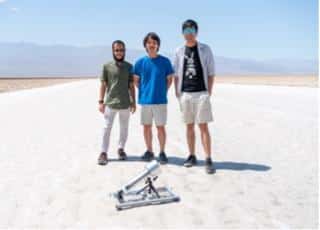Sorbent-assisted atmospheric water harvesting is a promising method for arid climates. A new water harvester using metal-organic frameworks was designed, constructed, and tested in California’s Death Valley National Park and Berkeley.
Researchers at the University of California Berkeley have created a handheld gadget that can capture and transform water molecules from the air into potable water using only ambient sunlight as its energy source.
The atmospheric water harvester extracts water repeatedly in Death Valley National Park, North America’s hottest and driest location, using an ultra-porous metal-organic framework (MOF) material. These studies demonstrated that the device could offer clean water everywhere, addressing a pressing issue as climate change exacerbates drought conditions.
Omar Yaghi, the Berkeley chemistry professor who invented MOFs and is leading this study, said, “Almost one-third of the world’s population lives in water-stressed regions. The UN projects in the year 2050 that almost 5 billion people on our planet will experience some water stress for a significant part of the year. This is quite relevant to harnessing a new source of water.”
Nearly one-third of the world’s population lives in water-stressed areas, and the UN predicts that by 2050, nearly 5 billion people will be affected by water stress of some form for a sizable portion of the year. Harvesters powered by MOFs can function simultaneously with high capacity, energy efficiency, and low humidity. Additionally, this technology can guarantee pure water in areas where clean water is plentiful but unclean.
The study provides an example of how specifically created MOFs might aid society in coping with and adapting to climate change. Data science and machine learning are being used by specialists at the Bakar Institute of Digital Materials for the Planet (BIDMaP) of the College of Computing, Data Science, and Society to speed up and scale the design of these molecules, materials, and devices.
Despite extremely low humidity and wide-ranging daily temperatures in Death Valley, the MOF-powered harvester gathered water repeatedly in both locations.
The MOF-powered harvester harvests water extraordinarily efficiently, releasing 85 to 90 percent of the water it catches as air vapor. It could extract up to 285 grams of water per kilogram of metal-organic framework daily, around a cup of water.

The MOF can run for many cycles over many years without being replenished or updated, and the MOF can be disassembled and reassembled in water with zero discharge and in a sustainable way at the end of its lifetime.
The experts who created the MOF and the gadget were ecstatic about what this meant for the environment. One distinguishing it from other clean-water generating technologies is that it is powered solely by ambient sunlight and does not require additional power sources to operate, meaning it does not emit greenhouse gases.
It’s also smaller than the previous MOF-powered harvester and small enough to fit in a handbag. Despite its smaller size, the device is now much more energy-efficient. It produced 200 grams of clean water per square meter of water vapor, more than tripling the water productivity rate of an earlier generation of a MOF-powered harvester developed by Yaghi’s team.
He said, “What we’re doing at BIDMaP is creating the digital innovation cycle.”
This early prototype will be improved in terms of efficiency, size, and scalability. Yaghi believes that one day, with data science and machine learning, the broad adoption of household-based MOF-powered water harvesters and community-scale water harvesters might be in kitchens or next to air conditioners to supply homes with clean water for cooking and washing.
Researcher said, “It gives individuals water independence.”
Journal Reference:
- Song, W., Zheng, Z., Alawadhi, A.H. et al. MOF water harvester produces water from Death Valley desert air in ambient sunlight. Nature Water. DOI: 10.1038/s44221-023-00103-7
